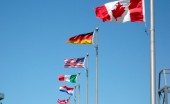Re Ian Bremmer 'Could third-party candidates upend the 2024 US election?' 3 April The current political movement in the USA…
New rules for US-Canada border crossing
Written by Diana Thebaud Nicholson // July 14, 2009 // Canada, David/Terry Jones, U.S. // Comments Off on New rules for US-Canada border crossing
How to fix the mess at the Canada-U.S. border
(National Post) The Brookings Institution has taken a look at the Canada-U.S. border mess and come up with some recommendations. Brookings is a respected Washington think tank generally considered Democrat-friendly. The report was written by Christopher Sands, a senior fellow at the Hudson Institute, where he specializes in Canada and U.S.-Canada relations. The conclusions lean toward decentralization of border responsibility so calls can be made by officials who understand the difference between Mexico and Canada, rather than by office-bound bureaucrats in Washington.
Toward a New Frontier Improving the U.S.-Canadian Border
In an age of international terrorism and illegal immigration, a well-functioning border is vital for homeland security. For the United States and Canada, however, it is also vital for national prosperity, for each is the other’s largest trading partner, and much of that trade is in intermediate goods that support the bi-national production of finished products, most notably autos. Roughly 400,000 individuals cross the border every day, many with deadlines for delivering cargo or reporting to work. This trade and travel supports jobs throughout both countries.
3 June
David Jones, as usual, gives a reality check on the passport requirements and makes some helpful suggestions. Unfortunately, he does not address the issue that concerns us (we have passports) the most – the slowing down of goods movement.
David Jones: Whinging won’t move border traffic
Canadians above all must realize that terrorism and U.S. security requirements will persist for the indefinite future. You might consider blaming the terrorists rather than U.S. government officials for the cost and inconvenience. The 9/11 terrorists did not transit Canada, but discerning observers know that they could have done so — easily. So when the next terrorist strike occurs, it behooves Canadians to have demonstrated that they have done everything possible to assure that no fault can be attributed to foot-dragging neglect in Ottawa.
1 June
Thanks to the Globe & Mail for some good “Border facts”
Passports, please: New border rules take effect
(CBC) Border guards began requesting passports as Canadians crossed into the United States on Monday as the Western Hemisphere Travel Initiative officially took effect just after midnight. “For a traveller what that means is we can no longer can take an oral declaration. We can no longer take a driver’s licence for identification,” said U.S. chief customs and border protection officer Tom Schreiber. People without proper documentation should be prepared to face delays, officials said. But border officials told CBC News that they would be “pragmatic and flexible” as the new rules are rolled in.
The Western Hemisphere Travel Initiative, an anti-terrorism policy passed by Congress in 2004, requires travellers 16 and older who are entering the United States from Canada by land or sea to carry one of the following:
* Passport.
* NEXUS card.
* Free and Secure Trade (FAST) card.
* Enhanced driver’s licence (EDL) or an enhanced identification card (EIC) from a province where a U.S.-approved EDL/EIC program has been implemented.
* Secure Certificate of Indian Status (when this certificate is available and approved by the United States).
Mexico and Caribbean countries are also affected by the legislation. There are no changes to border identification rules when entering Canada. Travellers with a valid driver’s licence and proof of citizenship can still enter Canada from the United States without a passport.
31 May
New passport rules about to hit
U.S. says it will go easy; tell us how you see it
(Montreal Gazette)
Despite official new regulations stating that you will no longer be able to enter the U.S. by car or boat without a passport or equivalent document starting June 1, officials have said they will be lenient.
29 May
US-CANADA: Shared Border, Unilateral Policy?
(IPS) – Canada and the United States are on different wavelengths when it comes to a shared and increasingly hardening of what had been a sleepy border within North America. One University of Toronto political scientist doubts this will change anytime soon in the wake of how “paranoia” in the U.S. about its northern frontier has continued under the administration of Barack Obama.
“The U.S. approach to border security has been consistently unilateral,” said Stephen Clarkson, the author of “Does North America Exist: Governing the Continent After NAFTA and 9/11” . “Canada and Mexico have the option of doing what the Americans want and then consulting about how they will do that,” he told IPS. “As for the continental perimeter, there is one in the sense that antiterrorism and visa regulations [for both countries] have largely been harmonised to U.S. standards. At the same time, the U.S. has reinforced its land borders. The result is that we have both a fortress North America and an internal U.S. wall,” he said.
28 May
Canada’s relations with the United States: Stop, border ahead
(The Economist) New border controls and protectionist bills have dashed Canadians’ hopes that the change of occupant in the White House would mean warmer relations
Some Canadians understand that their southern neighbour has real concerns about security, given the relative openness of its northern border. The [Canadian Chamber of Commerce] has been working with its American counterpart to propose ways of reducing border delays while maintaining adequate security. These include clearing shipments and people before they get to crossing-points.
The Practical Implications of the WHTI At last, a coherent and logical explanation of the whys and wherefores of the new requirements!
(Stratfor) On June 1, 2009, the land and sea portion of the Western Hemisphere Travel Initiative (WHTI) will go into effect. The WHTI is a program launched as a result of the Intelligence Reform and Terrorism Prevention Act of 2004 and intended to standardize the documents required to enter the United States. The stated goal of WHTI is to facilitate entry for U.S. citizens and legitimate foreign visitors while reducing the possibility of people entering the country using fraudulent documents.
The WHTI will greatly simplify the number of travel documents that immigration officials have to scrutinize. It will also mean that the documents needed to enter the United States will be far harder to counterfeit, alter or obtain by fraud than the documents previously required for entry. This will make it more difficult for criminals, illegal aliens and militants to enter the United States, but it will by no means make it impossible.
Identity document fraud has existed for as long as identity documents have. Like much sophisticated crime, document fraud has been an evolutionary process. Advancements in document security have been followed by advancements in fraud techniques, which in turn have forced governments to continue to advance their security efforts. In recent years, the advent of color copiers, powerful desktop computers with sophisticated graphics programs and laser printers has propelled this document-fraud arms race into overdrive.
27 May
Bush and Clinton in Toronto
… Mr. McKenna’s final question, and his plea that, because of our long and peaceful history of cooperation, Canadians feel a “profound sense of sadness” that we will now require passports to cross the US border. … By the time he protested, “We just thought we were special,” it was getting embarrassing.
“You are special,” Bush said. “I’ll be frank with you, Frank. I don’t know.” He said he tried to get an easy-pass into law, but did not know where that stands. Likewise, Clinton said he does not know anything about it, but that the question “got my attention, so I’m going back home to see if there’s anything that can be done.”
November 2008
Ron Robertson sends the following:
RHOMA colleague Michael Kergin (Senior Fellow, Graduate School of Public and International Affairs, University of Ottawa) and Birgit Matthiesen have co-authored a Canadian International Council report on the future of the Canada-US border. The report, A New Bridge for Old Allies, makes an urgent call for a constructive dialogue between the two countries and for new institutions to manage the border more intelligently.
22 January 2008
ID Rules To Change For Canada Crossings
DHS Defies Congress By Going Forward Now
(Washington Post) Defying Congress, the Department of Homeland Security is pushing to tighten identification requirements at U.S. land borders starting Jan. 31, when it no longer will allow Americans or Canadians to enter the country by presenting a driver’s license or declaring their citizenship.
The change is expected to worsen travel delays and backups along the U.S.- Canada border, which recorded 72 million crossings in 2007. The U.S.- Mexico border is even busier, with 226 million crossings, but noncitizens already need extra documentation to enter the United States there.
The shift at the northern border comes despite legislation approved by Congress last month that bars DHS from implementing a post-Sept. 11 regulation that requires all travelers entering the United States to present a passport or similar secure form of identification and proof of citizenship. That rule, passed in 2004 and set to take effect this month, was delayed until June 2009.
In pressing ahead, Homeland Security Secretary Michael Chertoff restated his belief that failure to act will lead to “another 9/11 Commission investigating a future attack by foreign intruders. But he also took a shot at critics in Congress, border states and trade organizations that have opposed the program, called the Western Hemisphere Travel Initiative.
“It’s time to grow up and recognize that if we’re serious about this threat, we’ve got to take reasonable, measured, but nevertheless determined steps to getting better security,” he told the Associated Press
The secretary’s remark raises the ante in a simmering battle with congressional leaders from border states, including Sens. Charles E. Schumer (D-N.Y.) and Patrick J. Leahy (D-Vt.) They have threatened to challenge the legal basis of DHS’s action and are drawing support from allies in Canada and powerful industry groups in both countries.
Noting that Chertoff’s department was forced to temporarily suspend a similar requirement for air travelers last summer when the rule caused a massive U.S. passport backlog, Rep. Thomas M. Reynolds (R-N.Y.) said the secretary “frankly has as much credibility on telling people to grow up as Geoffrey the giraffe.”
Leahy said that “with concerns about a recession on the way, the timing for clamping down on billions of dollars in trade and travel could not be worse. I can think of nothing that would push the northern border states over the edge more surely than this heavy-handed, ill-timed and misguided government mandate.”
Under the rule, people 19 and older will be asked to present a passport or, once they become available, an enhanced driver’s license or border pass card. Otherwise, both a regular driver’s license and a birth certificate or other citizenship document will be required.
In letters Thursday to Leahy and Schumer, Chertoff said DHS had authority under earlier laws passed by Congress to tighten identification requirements at borders.
Schumer aides took aim at the birth-certificate requirement, noting that Chertoff pointed out in June that such documents are issued by many jurisdictions and are easy to forge. Roger Dow, head of the Travel Industry Association, said DHS should require people to present only a driver’s license until a better alternative is ready in coming months. The State Department is scheduled to roll out more secure passport cards this spring.
A 2005 Conference Board of Canada study estimated that the travel initiative would cost the two countries and border communities $2.5 billion a year in reduced travel.
Chertoff said travelers must become accustomed to using the fewer forms of acceptable ID, rather than the 8,000 types now allowed, and that the United States must end the “honor system” of allowing people to declare citizenship at the border.
Over the past three years, DHS reported 31,060 cases of individuals trying to enter the country by falsely claiming to be U.S. citizens, including 1,517 in the past three months. The department did not say how many were caught on the northern border.
Border rules will make U.S. safer, Chertoff says
New requirements aren’t onerous, won’t deter trade and might prevent backlash against Canada, Homeland Security Secretary asserts
WASHINGTON — Americans will be safer next month after tougher document requirements are imposed at Canada-U.S. land-border crossings, Homeland Security Secretary Michael Chertoff said yesterday.
… Mr. Chertoff conceded that the new rules wouldn’t deter terrorists who had acquired Canadian identity documents, such as Ahmed Ressam, the so-called Millennium Bomber. “We are worried that al-Qaeda is deliberately trying to recruit people who appear to have or actually have legitimate paperwork from Western European countries or Canada,” he said. Complete article
OUR OPINION : Chertoff must back off on new border rule
Last week, President Bush said he’d like to use tax rebates to give “a shot in the arm” to the sluggish economy.
But if the economy needs a shot in the arm, why is the president at the same time giving it a poke in the eye?
For that’s what the new rules about crossing the border will amount to: Inconvenience and uncertainty, conditions that’ll hurt traffic and border states’ economies while delivering almost nothing in increased security.



